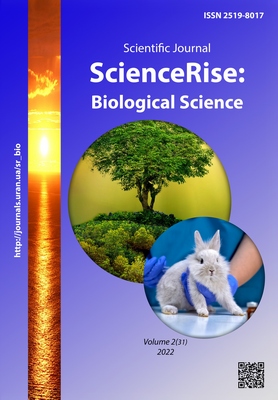Peculiarities of suction, extraction and assignment of calcium in experimental chronic hepatitis in rats
DOI:
https://doi.org/10.15587/2519-8025.2022.258790Keywords:
toxic hepatitis, hydrazine sulfate, calcium, small intestine, amino acids, hepatic osteodystrophyAbstract
The aim. Study the degree of absorption, assimilation, and excretion of calcium in rats with chronic toxic hepatitis.
Materials and methods. The studies were carried out on 1 month old Wistar rats. Toxic hepatitis in the experimental group was reproduced by intraperitoneal injection of hydrazine sulfate at a dose of 50 mg / kg twice a week. Studies of the absorption of substances in rats were carried out under thiopental anesthesia according to the Tyri method after 3 months of pathology modelling. In the intestinal contents, the amount of unabsorbed calcium and amino acids was determined. To determine the amount of assimilated and excreted calcium metabolic chambers were used for daily collection of urine, faeces and food residues, in which the calcium content was determined (average for three days per animal). After removing the rats from the experiment, the level of calcium in the blood serum was determined, in the bone tissue – the degree of its resorption by the activity of acid phosphatase and the content of calcium.
Results and discussion. Toxic hepatitis reduced calcium absorption by 34.5 % in the small intestine of rats and did not have a significant effect on amino acids, the inhibition of absorption of which in hepatitis was only 5.5 %. The excretion of calcium in the urine of rats with toxic hepatitis was reduced by 1.8 times, and with faeces, on the contrary, increased by 1.5 times. As a result, calcium absorption in rats with hepatitis decreased by 24.2 %. Decreased absorption of calcium, and its increased excretion in the faeces, led to a decrease in the level of this element in the blood of animals with hepatitis by 14.7 %. Our studies found bone destruction in rats with hepatitis: an increase in bone acid phosphatase activity by 65.3 % and a decrease in calcium levels by 15.5 %.
Conclusion. The triggering mechanism for the development of hepatic osteodystrophy is the inhibition of calcium absorption in the small intestine of rats with hepatitis, consequently - a decrease in its absorption and level in the blood, which ultimately leads to the activation of bone resorption. The established patterns will form the basis of the pathogenetic scheme for the prevention of hepatic osteodystrophy
References
- Zhdan, V., Ivanytsky, I., Shilkina, L. (2018). Expression of osteopengic changes depending on the degree of liver fibrosis. Young Scientist, 10 (62), 470–472.
- Velichko, A. V., Veialkin, I. V., Rozhko, A. V., Iaretc, Iu. I. (2019). Rasprostranennost giperkaltciemii sredi vzroslogo naseleniia Gomelskoi oblasti. Problemy zdorovia i ekologii, 1, 89–94.
- Golounina, O. O., Runova, G. E., Fadeyev, V. V. (2020). Osteomalacia in practice of endocrinologist: etiology, pathogenesis, differential diagnosis with osteoporosis. Osteoporosis and Bone Diseases, 22 (2), 23–31. doi: http://doi.org/10.14341/osteo12117
- Mogilevskaya, T. V., Makarenko, O. A., Gladkiy, T. V. (2021). Morphometric and Metabolic Disorders in the Bone Tissue of Laboratory Rats with Chronic Toxic Hepatitis. Ukrainian Journal of Medicine, Biology and Sport, 6 (3), 347–352. doi: http://doi.org/10.26693/jmbs06.03.347
- Kharchenko, N. V., Babaka, O. Ya. (Eds.) (2017). Hastroenterolohiia. Vol. 2. Kirovohrad: Polium, 432.
- Makarenko, O. A., Mogilevskaia, T. V. (2019). Sostoianie kishechnika krys posle toksicheskogo porazheniia pecheni. Biokhimiia i molekuliarnaia biologiia, 3, 210–214.
- Aksyonova-Seliuk, I. I., Panasenko, O. I., Knysh, Ye. H., Pruglo, Ye. S. (2016). The study of the effect of 5-(4-(tret-butyl)phenyl)-4-R-amino-4H-1,2,4-triazole-3-thiols on the duration of thiopental-sodium narcosis for laboratory rats. Zaporozhye medical journal, 5 (98), 93–96. doi: http://doi.org/10.14739/2310-1210.2016.5.82696
- Ugolev, A. M., Zaripov, B. Z. (1979). Metodicheskie priemy dlia izucheniia membrannogo pishchevareniia i vsasyvaniia v tonkoi kishke v usloviiakh khronicheskogo eksperimenta na krysakh i nekotorykh drugikh zhivotnykh. Fiziologicheskii zhurnal SSSR, 12, 1850–1854.
- Levitckii, A. P., Makarenko, O. A., Denga, O. V. (2005). Eksperimentalnye metody issledovaniia stimuliatorov osteogeneza. Kyiv: GFTc MZ Ukrainy, 50.
- Direktiva 10/63/EU Evropeiskogo parlamenta i soveta evropeiskogo soiuza «Po okhrane zhivotnykh, ispolzuemykh v nauchnykh tceliakh» 22.09.2010 (2010). Available at: http://www.bio.msu.ru/res/DOC457/Dir_2010_63_Rus-LASA.pdf
- Pro zatverdzhennia Poriadku provedennia naukovymy ustanovamy doslidiv, eksperymentiv na tvarynakh (2012). Nakaz Ukrainy No. 249. 01.03.2012. Available at: https://zakon.rada.gov.ua/laws/show/z0416-12#Text
- Seliverstov, P. V., Radchenko, V. G., Safronenkova, I. G., Sitkin, S. I. (2010). Vzaimootnosheniia pecheni i kishechnika na fone disbalansa mikroflory tolstoi kishki. Gastroenteroogiia, 2-3, 15–18.
- Povorozniuk, V. V. (2014). Sostoianie problemy osteoporoza i drugikh metabolicheskikh zabolevanii skeleta v Ukraine. Novosti meditciny i farmatcii, 3 (487), 10–13.
- Shvarts, H. Ya. (2009). Vytamyn D, D-hormon y alfakaltsydyol: medytsynskye, molekuliarno-byolohycheskye y farmakolohycheskye aspekti. Ukrainskyi revmatolohichnyi zhurnal, 3, 63–69.
- Sivri, S. K. (2010). Vitamin D metabolism. Calcium and vitamin D metabolism. ITA, 256.
Downloads
Published
How to Cite
Issue
Section
License
Copyright (c) 2022 Tatiana Mogilevskaya, Olga Makarenko, Larissa Khromagina

This work is licensed under a Creative Commons Attribution 4.0 International License.
Our journal abides by the Creative Commons CC BY copyright rights and permissions for open access journals.
Authors, who are published in this journal, agree to the following conditions:
1. The authors reserve the right to authorship of the work and pass the first publication right of this work to the journal under the terms of a Creative Commons CC BY, which allows others to freely distribute the published research with the obligatory reference to the authors of the original work and the first publication of the work in this journal.
2. The authors have the right to conclude separate supplement agreements that relate to non-exclusive work distribution in the form in which it has been published by the journal (for example, to upload the work to the online storage of the journal or publish it as part of a monograph), provided that the reference to the first publication of the work in this journal is included.









